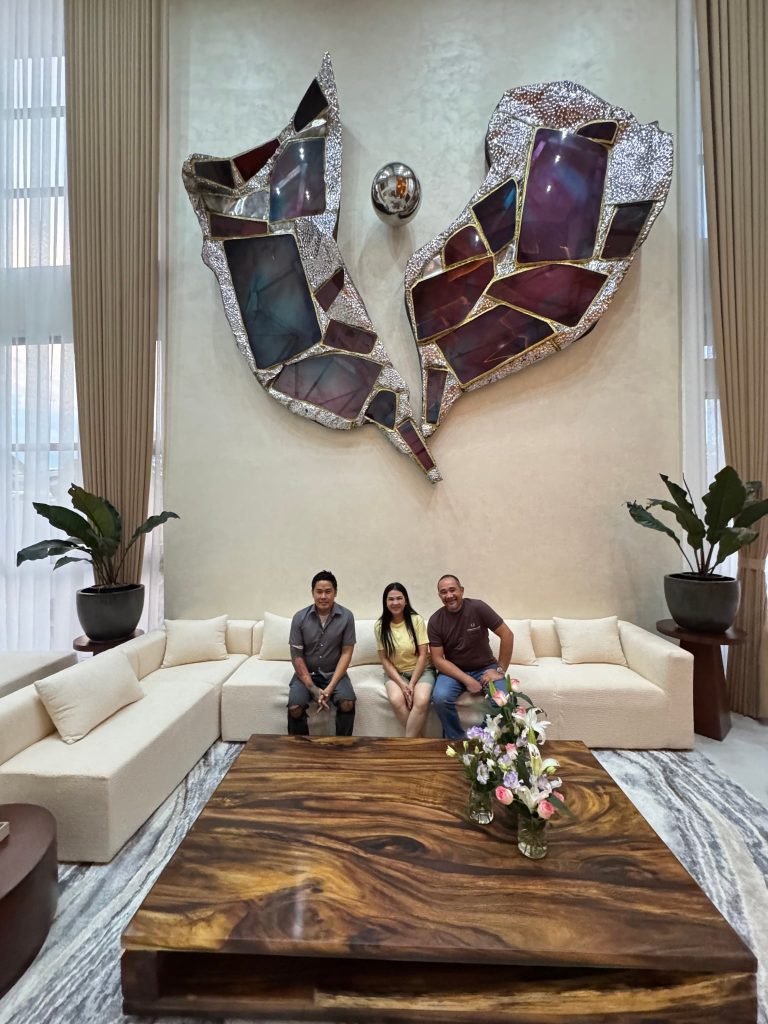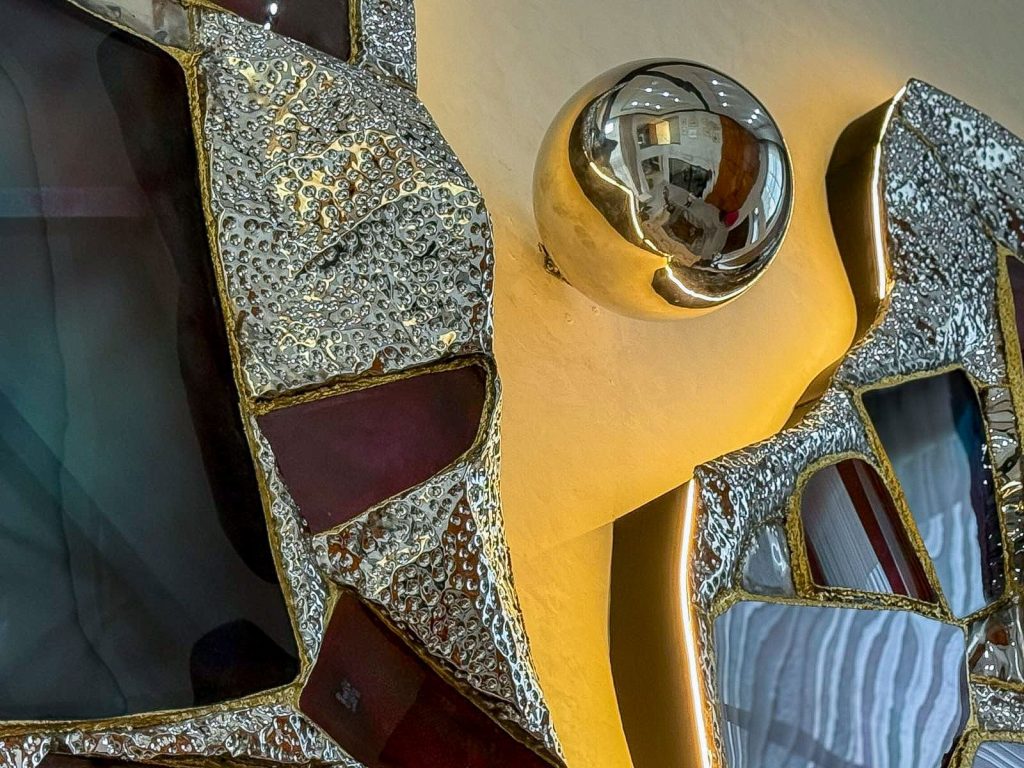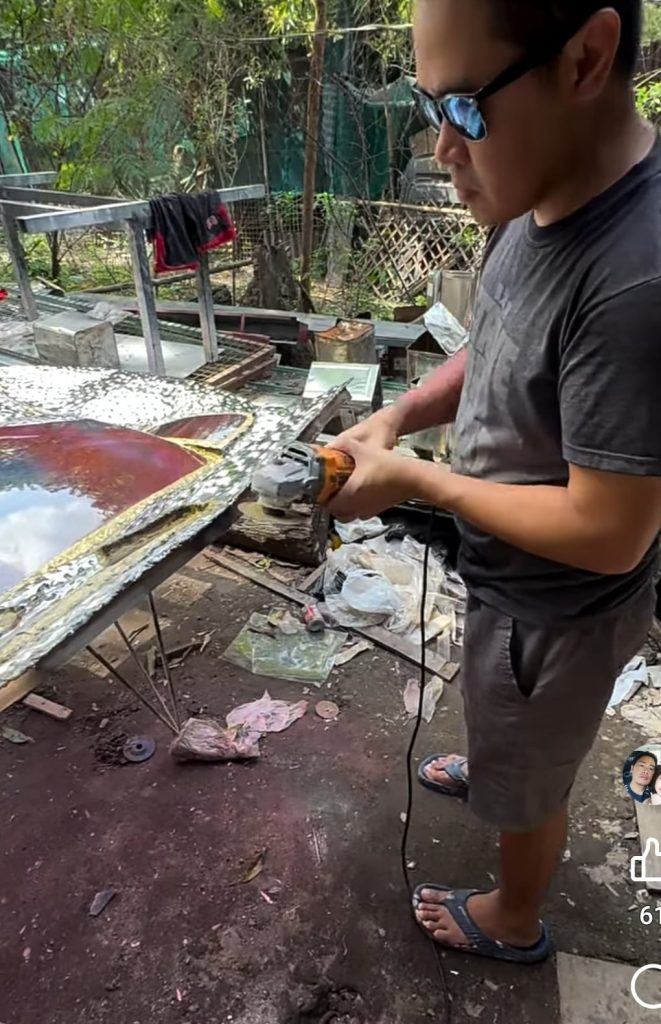
It gleams—metal reflecting light, punctuated by colored glass. With every step and shifting glance, it catches the eye, flickering subtly in response to sunlight. The surface shimmers as sunrays hit, giving the piece a quiet, dynamic presence.
At Ciudad de Hizon in San Fernando, Pampanga, a large-scale sculpture titled Paragon of Virtue quietly occupies a prominent space in the private residence of collectors Jayvee and Janet David. Measuring 12.5 feet high and 10 feet wide, the high-relief work by Ron Salazar is a commission meant to memorialize their late child—translated into a visual language that draws heavily from industrial material and sculptural precision.
Salazar, a seasoned fabricator and trained painter, brings together two worlds in this work: the fine art discipline of composition and form and the practical knowledge of metalwork and industrial processes. The result is a piece that functions both as a personal tribute and as an example of how contemporary art practices in the region are expanding through material exploration.
Grounded in Fabrication

Salazar’s background is deeply embedded in both art and industry. He underwent a two-year painting workshop under Norman Sustiguer at the University of the Philippines Diliman, but much of his technical knowledge comes from years of hands-on work in the fabrication sector. He is self-taught in arc welding, TIG welding, torch welding, and glass carving—skills not conventionally associated with the area, where woodwork is more popular, but which have become central to his practice.
This mix of disciplines gives his work a practical edge. Rather than romanticize his materials, he engages with them directly. Stainless steel and tempered auto glass—typically found in vehicle construction—are not used for symbolism alone, but for their physical properties: durability, surface quality, reflectivity, and light transmission.
The Paragon of Virtue sculpture was developed through close consultation with the commissioning family. The work features a stylized angel form, assembled through abstracted elements: a heart, two leaves, a sphere, and fragmented wings. These forms reference the themes of love, memory, and transition—specifically relating to the family’s experience of loss and reimagining presence.
Salazar began with a full three-dimensional model to study the structure and spatial relationships before constructing the final version. His technical approach relies on measured accuracy and careful assembly. Though biomorphic in shape, the form is more in line with engineering than studio sculpture. The process involved precise cutting, controlled welding, and glass carving—each step contributing to the final composition without excess embellishment.
What distinguishes Salazar’s practice is his clear preference for letting material guide meaning. He does not overstate the emotional content of his work. Instead, he allows the physical behavior of steel and glass—strength, brittleness, weight, reflectivity—to speak through form and contrast.
This aligns with broader trends in contemporary Filipino sculpture, where artists increasingly draw from construction and fabrication techniques. Salazar’s experience with industrial processes is not treated as a secondary skill set but as a central part of his methodology. His sculptural language is rooted in the logic of assembly rather than gesture or spontaneity.
Career Markers

Salazar’s work has been recognized by multiple institutions. He won a gold medal at the 54th Annual Art Association of the Philippines competition in 2001 (Sculpture) and earlier received honors at competitions hosted by Shell, UST, Westin Philippine Plaza, and the Colegio de San Lorenzo. His piece was also included in the Development Bank of the Philippines’ millennium calendar in 2000.
Currently based in Sta. Rita, Pampanga, Salazar continues to refine his technique with plans to explore new conceptual directions while maintaining his use of stainless steel and tempered glass. He is not focused on rapid stylistic shifts but on technical mastery and careful innovation.
Paragon of Virtue demonstrates how contemporary memorial art can merge industrial precision with personal intent. For Salazar, the work is part of an ongoing effort to expand his visual vocabulary using materials more often associated with machines than monuments. In doing so, he contributes to a broader redefinition of sculpture in the local context—where technical fluency and conceptual clarity can meet without spectacle.




